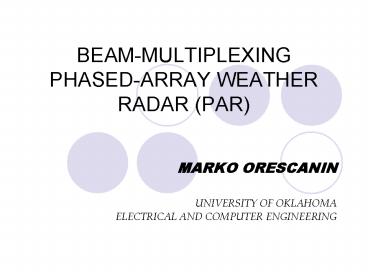BEAMMULTIPLEXING PHASEDARRAY WEATHER RADAR PAR - PowerPoint PPT Presentation
1 / 26
Title:
BEAMMULTIPLEXING PHASEDARRAY WEATHER RADAR PAR
Description:
ELECTRICAL AND COMPUTER ENGINEERING. SOMETHING ABOUT THE AUTHOR. Graduate Research Assistant at University of Oklahoma, working toward master of ... – PowerPoint PPT presentation
Number of Views:100
Avg rating:3.0/5.0
Title: BEAMMULTIPLEXING PHASEDARRAY WEATHER RADAR PAR
1
BEAM-MULTIPLEXING PHASED-ARRAY WEATHER RADAR
(PAR)
- MARKO ORESCANIN
- UNIVERSITY OF OKLAHOMA
- ELECTRICAL AND COMPUTER ENGINEERING
2
SOMETHING ABOUT THE AUTHOR
- Graduate Research Assistant at University of
Oklahoma, working toward master of science degree
under guidance of Dr.Tian-You, Yu - Graduate of the University of Belgrade, School
of Electrical and Computer Engineering, Belgrade
,Serbia
3
Acknowledgements
- I would like to thank the people from the NSSL
Laboratory especially Dr.Dusan Zrnic and his
group in particular Christopher Curtis, Igor Ivic
and Dr. Sebastian Torres for their help and
advices.
4
CONVENTIONAL VERSUS ELECTRONIC
CONVENTIONAL
PAR
5
Comparison
- WSR-88D
- Dish antenna
- Reflector diameter 28.02 feet
- AZ/El Nominal Beamwidth 1.0o
- Mechanical limits -1.0o to 60o in Elevation
- Dual Polarization
- PRFs 320Hz to 1300Hz
- Pulsewidth1.57µs,4.51µs
- PAR
- Phased-Array antenna (4352 element)
- 12 foot aperture, mounted with 10o tiltback
- AZ/El Nominal Beamwidth 1.6o(2.3o at 45o off
broadside) - Linear Vertical Polarization
- PRFs318Hz to 1304Hz
- Pulsewidth1.57µs,4.71µs
6
BEAM-MULTIPLEXING
- In a beam-multiplexing regions of interest are
re-sampled after weather signals become
uncorrelated - As a result, the statistical error of spectral
moment estimation can be reduced optimally
through the average of a number of independent
measurements.
7
INDEPENDENT SAMPLES
- Idea behind Beam-Multiplexing is finding a way
to collect independent samples - Gaussian Power Spectrum - correlation coefficient
is given by (Doviak and Zrnic 1993) - Correlation coefficient depends on the spectrum
width, time between samples and wave length
8
VARIANCE OF ESTIMATORS
- Power for Contiguous Pairs
- Power for Independent Pairs
9
VARIANCE OF ESTIMATORS
- Velocity
- for TTs contiguous pairs case otherwise
independent pairs case
10
SPECIAL CASE
- 20 dB SNR level
- 1 dB standard deviation limit for reflectivity
- 1 ms-1 standard deviation limit for velocity
11
IMPLEMENTING BEAM-MULTIPLEXING
- In order to implement beam-multiplexing three
constraints were taken into account - FOR SMALL SPECTRUM WIDTH OF 1ms-1 AND PRT1ms
DECORRELATION TIME IS 20 ms - 6o ANGULAR POSITION SEPARATION BETWEEN TWO
SUBSEQUENT BEAM POSITIONS IN ORDER TO AVOID
SECOND AND THIRD WAY ECHOES (CHRISTOPHER CURTIS
2002) - PAIR OF PULSES ARE TRANSMITTED AT EACH POINTING
POSITION,WITH SPECIFIED PRT BETWEEN THE PULSES
12
SCANING CELL PATTERN
13
2
9
11
5
7
1
3
12
14
8
10
4
6
13
EXPERIMENT
- SETUP
- PRT 1ms
- Sampling 2.5 MHz
- Pulsewidth 1.57µs
- Trans. freq.3.2 GHz
- SCANING STRATEGY
- Sector of 28o was repeatedly scanned using two
subsequent strategies - First strategy consisted of two
beam-multiplexing cells with 1o separation
between positions that formed a 28o scan - Second strategy mimics continuous sampling, with
fixed beam positions in space separated by 1o
covering a 28o scan
14
DEMONSTRATION OF SCANING STRATEGIES
BEAM MULTIPLEXING
CONVENTIONAL
15
PPI REFLECTIVITY
BEAM MULTIPLEXING
CONVENTIONAL
16
PPI VELOCITY
BEAM MULTIPLEXING
CONVENTIONAL
17
RESULTS
18
RESULTS
19
WHITENING
- Number of independent samples from data
oversampled in range can be increased by range
time decorelation of data. - Data can be decorrelated in range time with the
help of whitening technique
20
Correlation in range
Estimates from adjacent range bins can be
averaged
21
(No Transcript)
22
DIAGRAM
Time series data
Decorelated time series data
Whitening Matrix
23
Whitening Matrix
Whitening matrix is
It has been shown that if C is positive
semidefinite, symmetric matrix then if time
series data are multiplied with white matrix
product will give time series data with samples
uncorrelated in range
24
If we use matrix notation the correlation matrix
is given as
We decompose this matrix
25
PRELIMINERY RESULTS
26
Reference
- Doviak, R. J., and D. S. Zrnic, 1993 Doppler
radar and weather observations. 2nd ed. Academic
Press, Inc., 562 pp. - Ivic, I.,2001Master Thesis Demonstration of
Efficient Method for Estimating Spectral Moments. - Christopher Curtis,2002 National Weather Radar
Testbed






























